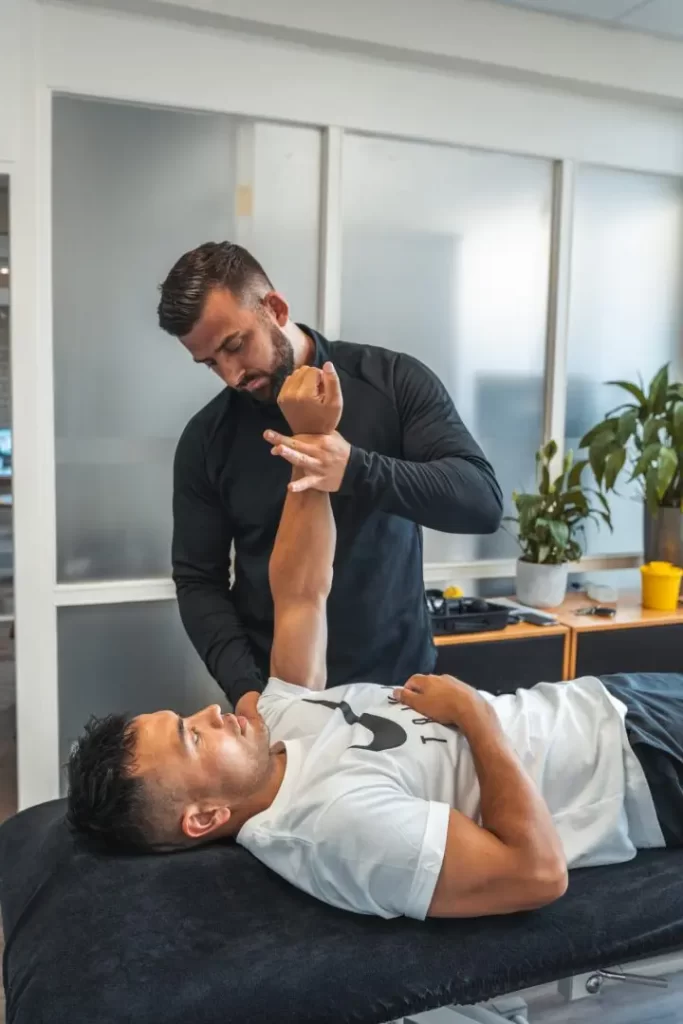Hamstring complaints in runners
Hamstring complaints are common among runners. Pain and loss of strength are common symptoms of hamstring injuries. A hamstring injury often occurs during a specific and explosive movement, for example sprinting, lunging passes and when bending the knee (against resistance). The muscles involved in a hamstring injury are the biceps femoris muscle, the semitendinosus muscle and the semimembranosus muscle. In some cases, we speak of a sprint or stretch type hamstring injury. A sprint type hamstring injury is the most common and usually occurs during an explosive rapid onset for a (for example) sprint movement (athletics). In this blog, we explain to you in more detail what types of acute hamstring injuries there are and how we treat them at Fysio Fitaal in Tilburg.

Cause
Cause
Risk factors
- Building up too quickly in training (without using a warm-up)
- Age group: 18-35
- Sprint-related sports (often explosive in nature); athletics, football, hockey, high jump.
- Stretch movements; gymnastics, crossfit, gymnastics-related movements
- Degeneration of tendon tissue due to old age
- Smoking, poor diet (lifestyle), obesity, cardiovascular disease
- Already familiar with hamstring problems
- Past muscle tear (rupture)
Complaints and symptoms
Complaints and symptoms

Common hamstring diagnoses among runners
Sprint type hamstring injury
Related to sprint or heavy weight exercises. A sprint type hamstring (type 1) occurs during sprint, jump and or fast kick/kick movements. And is also the most common type of hamstring injury when it comes to type 1 or 2. Often, the moment of a hamstring tear occurs just before the foot hits the ground. During the swing phase or footstrike are the moments when the hamstring is most maximally activated in its maximum length, when also the knee and ankle movement is performed simultaneously in an eccentric manner.
Stretch type hamstring injury
An acute hamstring injury (type 2) is stretch-related which is often seen in dancers and gymnasts (gymnastics). During these movements, the muscles are at their longest due to hip flexion (flexion). This type of hamstring injury is less acute with respect to pain and often causes less restriction than a type 1 hamstring injury. Often the rehabilitation time of type 2 does take longer due to the location of the injury, often this is at the level of the muscle to the insertion. In fact, tendon tissue has a longer recovery time compared to a muscle injury. The most common muscle in which a stretch type injury occurs is the musculus semimembranosus.
Gradations of hamstring tear
- Grade 1: Mild muscle tear. Minimal presence, no obvious loss of strength.
- Grade 2: Moderate muscle tear. Obvious tearing of muscle fibres and occurrence of loss of strength.
- Grade 3; Total rupture. least common. Possible indication for surgery if diagnosed promptly.
Treatments and prognosis
Treatments and prognosis
At Fysio Fitaal in Tilburg, we use ultrasound to classify the severity of the injury. Should further diagnostic testing be necessary, we link this back to the GP.
Rehabilitating with a hamstring injury
Rehabilitation from a hamstring injury takes time. The number one risk factor for developing a hamstring injury is a past hamstring injury! That is, the region loses a lot in strength and coordination after a serious injury. So it is really important to make a logical and responsible build-up until you resume your sports activities such as running. Specific strength training for the hamstring group is important. Here we build up from low-loading exercises like isometric exercises to eccentrically loaded exercises where we mimic the sport-specific situation as much as possible. At Fysio Fitaal in Tilburg, we use an extensive test battery to minimise the risk of a new injury.
Rehabilitating together
Hamstring injuries are often difficult injuries and often recur when not treated properly. Knowledge of training theory and a logical build-up of training load are crucial. At Fysio Fitaal in Tilburg, we will help you get back on the court, the field or in the gym as soon as possible! Together, we work step by step towards a pain-free and healthy situation to get back to sports with full enthusiasm.
Are you looking for professional sports physiotherapy? Then send an e-mail to info@fysiofitaal.nl or get in touch via en contact form.
Related complaints

Hamstring
The hamstrings are a group of muscles at the back of your thigh. This muscle group...
Making an appointment at FysioFitaal
We work from multiple locations in Tilburg, always close by for professional and accessible physiotherapy. Fill in the contact form and we will contact you soon. Together, we will work on your recovery!

